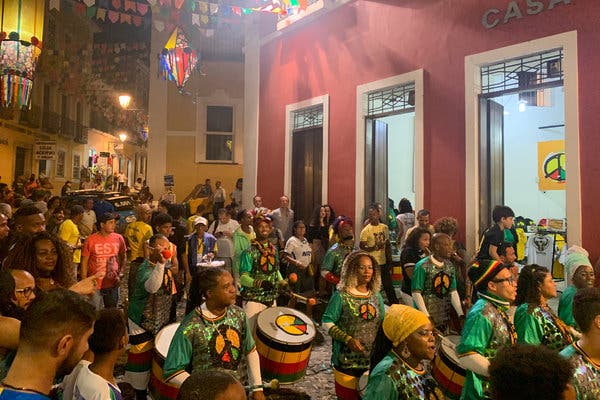
CreditSebastian Modak/The New York Times
Our columnist, Sebastian Modak, is visiting each destination on our 52 Places to Go in 2019 list. Before Salvador, his previous stop was Aberdeen, Scotland, where street art enlivened the walls.
For the first time in six months, I would have to rely on memory alone: No cameras allowed. In my packed section of male spectators (women were at the other end of the room), there wouldn’t have been enough space to lift my camera to my face even if I’d been allowed.
The pattering of long cylindrical atabaque drums, a sound like rainfall with occasional syncopated claps of thunder, bounced off the room’s white walls. Over a floor strewn with leaves, women dressed in billowing white dresses danced in circles while answering every sung call from the lead drummer. Occasionally, a dancer would fall into a trance, body shaking, head rolled back until another woman would approach her, rub her back and whisper words that would bring her back to this plane.
Over the course of the night, I watched as practitioners of Candomblé, a religion originating with the enslaved Africans brought to Brazil hundreds of years ago, paid their respects to Oxóssi, one of the pantheon of orixás that form a link between this world and that of the divine. For four and a half hours, the music barely stopped.
The drums and singing were still going as I walked away from the house and down an alleyway in Salvador’s neighborhood of Federação.
The event was a rare opportunity for outsiders like me to witness the rites of Candomblé, a faith, which like its sister religion in Cuba, Santeria, has a long history of secrecy and resistance, having survived generations of Catholic colonialists. These public ceremonies are held at the Terreiro do Gantois every month, but they are not marketed to tourists. A friend of a friend told me where to go and when. It was telling that the spectators were largely Brazilian and it was indicative of how overwhelming Salvador can appear, but how, once you find your way in, the rewards can be intoxicating.
Salvador, the capital of the Brazilian state of Bahia, is home to more than 2.5 million people and is one of the largest black-majority cities outside of Africa. Its streets, a result of very little city planning, loop and wind between neighborhoods spread into two main sections, the Cidade Baixa (or “low city”), which hugs the coastline, and the Cidade Alta (or “high city”), where the Portuguese set up Brazil’s first capital in 1549. The city is the picture of faded colonial grandeur: colorful facades appear desaturated by time and sunshine, and tangled telephone wires run over sloping cobblestone streets. Even with the threat of occasional winter downpours, the city’s beaches are packed, where vendors sell sticks of cheese that they roast over coals and sprinkle generously with oregano. For a handful of reais, someone will set you up with chairs and an umbrella and bring you cold beer and grilled seafood until you tell them to stop.
Warnings about crime
But the city isn’t without its problems. Brazil is consistently rated among the most unequal countries in the world, and that wealth disparity can lead some to desperation. Danger, in the form of petty theft and muggings, seemed to be on many people’s minds and it was often tough to tell which warnings warranted my attention and which were clouded by paranoia, classism or racism. In Pelourinho, the historical center that is wrapping up a multi-year face lift — an effort that helped land it on the 52 Places to Go 2019 list — police patrolled the tourist-friendly stretch packed with caipirinha stands and souvenir shops. But I was repeatedly told not to venture even a few streets over.
As a result, I felt the need to be more alert and cautious than I have been in other stops on this trip. I was aided, however, by a network of friends of friends who provided much-needed advice on where to go (and where not to go) and by the fact that, for the first time this year, I wasn’t traveling alone. My partner Maggie had flown to Salvador to meet me.

Still, I felt a semblance of guilt as we took Uber after Uber, heeding advice, for example, not to walk to a restaurant 15 minutes away. I like to assume the best in people — and doing just that has led to some of the most memorable travel experiences of this trip. I’m not naïve: I’ve been in my fair share of scary situations, including many in the United States. But finding myself in a place where I felt I had to put up walls was difficult for me to adjust to quickly, and, for the first couple of days, the city felt impenetrable.
Finding the beat
When we decided to follow the music Salvador opened up. Rhythm and melody are everywhere, and I mean everywhere. In Pelourinho, bloco-afros, or percussion crews that often double as community service organizations, rehearsed samba reggae rhythms in the streets. Tuesday night brought out a particularly joyous crowd for the weekly show put on by Olodum, the bloco made famous through collaborations with the likes of Michael Jackson. Roadside shops blared forró, a propulsive musical style, through overworked speakers in attempts to drown each other out.
The perpetual party was even more energized than usual because the city was playing host to the Copa America, the South American soccer tournament, and the Dia de São João (Day of St. John), which passes in other parts of Brazil with barely a blink but is a major event in the northeast of the country, was approaching
A sampling of the music Sebastian encountered during his week in Salvador
At the Teatro Castro Alves, the Bahia Symphony Orchestra went full Casual Friday, decked out in plaid and jeans, and churned out forró classics in celebration of São João. By the encore, everyone had left their seats and Maggie and I found ourselves twirling with strangers.
I met Gabi Guedes at the Candomblé ceremony we attended and he offered at least one perspective as to why music plays such a prominent role in daily life. Mr. Guedes had been described to me by the owner of Cana Brava, a small but mighty record store in Pelourinho, as having “the hands of God.” A lifelong percussionist who started playing drums at age five because, in his words, he “heard the music in the wind,” Mr. Guedes has had a long and successful career as a touring percussionist with practically every world-famous Brazilian artist, along with international acts like Jimmy Cliff. He plays a major role in the local Candomblé community and sees it as integral to all the music that pervades the city.
“Music in Bahia is how we maintain a connection with our ancestors,” he said, talking over the competing sounds of the Candomblé drums and São João fireworks from elsewhere in the neighborhood. “It’s in everything. It gives us power, it gives us direction, it gets us through the day by day. It helps us understand who we are as people.”
Other things I loved in Salvador:
-
Stands selling beiju, a kind of crepe made from tapioca, are everywhere in Salvador and it is baffling to me that the streets of New York and Los Angeles aren’t filled with hip food trucks hawking the stuff. A thin layer of tapioca is covered in a choice of fillings, savory and sweet, and folded in half like a taco. Try one filled with carne-de-sol, a salted and sun-cured beef, for starters. Addiction guaranteed.
-
Salvador’s beaches are world-famous for a reason, but you don’t get the full picture unless you visit more than one. Start with the easily accessible Praia do Porto da Barra, which faces the Bay of All Saints and is one of the best spots in the city to take in the sunset, and, just around the bend, the Praia do Farol da Barra. At both, you’ll find a mix of more well-to-do locals and tourists. For something completely different head out to Itapuã on a Sunday to see a beach packed to the brim with extended families enjoying a day off.
-
Everyone has an opinion on where to get the best moqueca, the signature palm oil-based stew famous in Salvador. The best I had was at Casa de Tereza, a spot tucked away in a corner of Rio Vermelho. It’s a modernized version of the dish to be sure, but it undeniably hits the spot.
A pick-up soccer game unfolds at the Praia do Farol da Barra.Credit
In so many parts of the world, culture rooted in black communities has at one point or another faced attempts at whitewashing: Just look at all the buttoned-up white jazz ensembles that emerged across the United States in the early 20th century. It was refreshing to see so much of the Afro-Brazilian culture in Salvador still intimately connected to the city’s black community, despite (or perhaps because of) generations of collective trauma.
In the historical center, where a slave auction once stood, today a group of black capoeira acrobats and musicians set up every day and put on a show. The food of the city, like moqueca, feels like it was lifted straight from West Africa — because it was. One afternoon, before Maggie had arrived and still dazed from a redeye flight, I sat on a plastic stool on the side of the road and ordered acarajé, black-eyed peas deep fried into a mash and stuffed with tiny shrimp, cashews and palm oil. Speaking in a purposefully clumsy Spanish I hoped would pass as Portuguese, I asked the woman the story of the dish. She looked at me confused and with a heavy “no duh” tone replied simply, “Africa.”
As powerful and integral as Salvador’s African heritage is, it’s almost contradictory that outsiders like me still mostly discover it through the eyes of the white people it fascinated. Until that night in the Terreiro do Gantois, everything directly related to Candomblé that I encountered had been through a white lens. There were the stunning photographs by Pierre Verger, the French photographer for whom Bahia and its culture became an obsession, on display at the museum of photography, Espaço Pierre Verger. The novelist Jorge Amado’s home has been turned into a museum and a hut tucked away in the house’s garden tells the story of Mr. Amado’s own respect for and fascination with the religion. The highlight of the Afro-Brazilian Museum at the Federal University of Bahia is the room filled with floor-to-ceiling panels depicting the different orixás carved by the Argentinean-born artist known as Carybé. To witness any of that culture firsthand is an immense privilege.
In all its complexity, Salvador is a hard place to make connections and revel in serendipity. But the times that it does happen can rewire your brain. One night, Maggie and I headed to Rio Vermelho, the hip neighborhood of bars and restaurants on the southern edge of the peninsula. The idea was to grab a drink and a snack and get an early night. On a patio, a samba band blared. People danced as if they had the lifelong training of a professional troupe and we found ourselves in the fray. The hours passed and the band kept going. Knowing Maggie is generally early to bed, I suggested that maybe it was time to head back to the hotel.
“Let’s just stay a little longer,” she replied.







